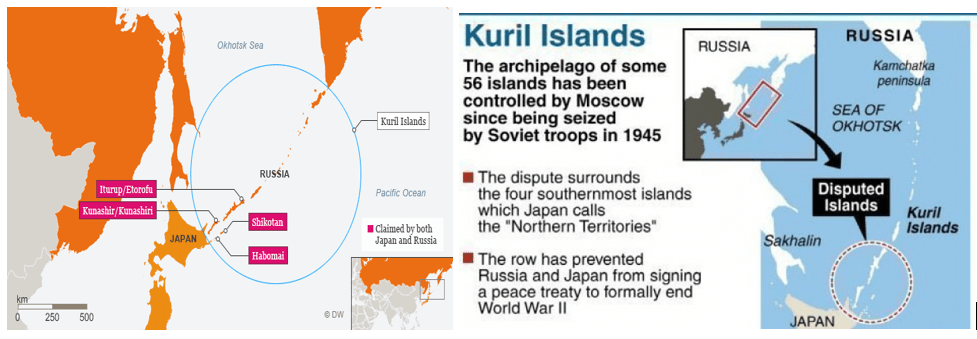International Relations
Kuril Islands
- 26 Mar 2020
- 7 min read
Why in News
Recently, a 7.5 magnitude earthquake struck in the northern Pacific and a tsunami warning was issued for the closest shores on Russia’s far eastern Kuril Islands.
- The earthquakes of this strength in the region have caused tsunamis in the past far from the epicenter of the earthquake.
- The epicenter is the point on the Earth's surface directly above a hypocenter or focus.(The hypocenter is where an earthquake or an underground explosion originates.)
Geographic Location of Kuril Islands
- Kuril Islands are stretched from the Japanese island of Hokkaido to the southern tip of Russia's Kamchatka Peninsula separating Okhotsk Sea from the North Pacific ocean.
- It consists of 56 islands and minor rocks.
- The chain is part of the belt of geologic instability circling the Pacific and contains at least 100 volcanoes, of which 35 are still active, and many hot springs.
- Earthquakes and tidal waves are common phenomena over these islands.
Importance of South Kuril Islands
- Natural resources:
- The islands are surrounded by rich fishing grounds and are thought to have offshore reserves of oil and gas.
- Rare rhenium deposits have been found on the Kudriavy volcano on Iturup.
- Nickel-based superalloys of rhenium are used in the combustion chambers, turbine blades, and exhaust nozzles of jet engines.
- Tourism is also a potential source of income, as the islands have several volcanoes and a variety of birdlife.
- Strategic Importance:
- Russia has deployed missile systems in the region.
- Russia also plans a submarine project and intends to prevent any American military use of the islands.
- Cultural Importance:
- The Japanese people, especially conservatives in Hokkaido, are emotionally attached to the islands.
Historical Background of Kuril Islands Dispute
- Sovereignty Issue of South Kuril Islands:
- The Kuril Islands dispute between Japan and Russia is over the sovereignty of South Kuril Islands.
- The South Kuril Islands comprises Etorofu island, Kunashiri island, Shikotan island and the Habomai island. These islands are claimed by Japan but occupied by Russia as successor state of the Soviet Union.
- These islands are known as Southern Kurils by Russia whereas Japan calls them Northern Territories.
- Original Inhabitants-Ainu People:
- The Kurils were originally inhabited by the Ainu people, and they were later settled by the Russians and Japanese, following several waves of exploration in the 17th and 18th centuries.
- The Ainu or the Aynu, also known as the Ezo in the historical Japanese texts, are an indigenous people of Japan and Russia.
- Treaty of Shimoda (1855):
- In 1855, Japan and Russia concluded the Treaty of Shimoda, which gave control of the four southernmost islands to Japan and the remainder of the chain to Russia.
- Treaty of Saint Petersburg (1875):
- In the Treaty of Saint Petersburg, signed between two countries in 1875, Russia ceded possession of the Kurils to Japan in exchange for uncontested control of Sakhalin Island.
- Yalta Agreement (1945):
- In 1945, as part of the Yalta agreements (formalized in the 1951 Treaty of Peace with Japan), the islands were ceded to the Soviet Union, and the Japanese population was repatriated and replaced by Soviets.
- The San Francisco Peace Treaty signed between the Allies and Japan in 1951, states that Japan must give up “all right, title and claim to the Kuril Islands”, but it also does not recognize the Soviet Union’s sovereignty over them.
- Japan-Soviet Joint Declaration (1956):
- The dispute over the islands has prevented the conclusion of a peace treaty to end World War II.
- In 1956, diplomatic ties were restored between Japan and Russia by Japan-Soviet Joint Declaration.
- During that time, Russia offered to give away the two islands closest to Japan. But the offer was rejected by Japan as the two islands constituted only 7% of the land in question.
- Developments After 1991:
- Despite a series of agreements, the dispute continues and Japan still claims historical rights to the southernmost islands and has tried repeatedly to persuade the Soviet Union and, from 1991, Russia to return those islands to Japanese sovereignty.
- In 2018, the Russian President and the Japanese Prime Minister (PM) met on the sidelines of the East Asia Summit and decided to end the territorial dispute by Japanese PM agreeing to negotiate based on the 1956 declaration.
- This implicitly showed that Japan has given up the two islands to maintain peace with Russia.
- However, Russia indicated that the joint declaration signed by Japan and the Soviet Union in 1956 neither mentions a basis for returning Habomai and Shikotan nor clarifies which country has sovereignty over the islands.
- Further, in 2019, Japanese PM made it clear that the country is not in the favour of withdrawing control over the Islands. Japan also believes that the islands are the inherent part of the nation’s territory. Therefore, Japan mentioned that it aims to sign the peace treaty after the territorial issue is resolved.





